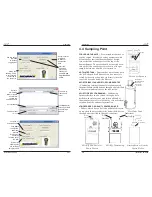
Instruction 24-9448
3-14
Initial Setup
3.14 Battery Charger Selection
When using rechargeable NiMH batteries, the AC
power adapter can be used to charge the batteries
while inside the analyzer. The analyzer’s rapid-
charger circuit, however, must be first turned ON.
IMPORTANT:
When using disposable alkaline
batteries, the analyzer’s battery charger circuit
should be OFF to prevent the batteries from
overheating.
As a precaution, the charger circuit is automati-
cally toggled to its OFF state when the analyzer is
turned OFF, thus requiring the operator to turn
the charger back ON when needed.
Note: The PCA2 must be left turned ON to
charge the batteries.
Turn the battery charger circuit ON and OFF as
follows:
1. Display the MAIN MENU by pressing the
MENU (F2)
button. If necessary, press
ESC
until
MENU appears above
F2
.
2. Use the
buttons to highlight SETUP, and
then press
ENT
to display the SETUP MENU.
3. Use the
buttons to highlight BATTERY
CHARGER, and then press
ENT
to display the
BATTERY CHARGER screen.
4. Use the
buttons to highlight either OFF
(turn charger OFF) or ON (turn charger ON).
In the example shown, ON has been selected.
5. Press
ENT
to save the selection and re-display the SETUP MENU.
BATTERY CHARGER
OFF
ON
05/26/06 09:25:30 AM
MENU
F1
F2
F3
MAIN MENU
FUEL
PRESSURE
TEMPERATURE
MEMORY
SETUP
CALIBRATION
DIAGNOSTICS
STATUS
F1
F2
F3
MENU
SETUP MENU
(more)
TIME
O
2
REFERENCE
PRINT PRESSURE
ZOOM
BATTERY CHARGER
LOGGING
(more)
MENU
F1
F2
F3
Instruction 24-9448
5-8
Calibration
5.6 CO-LO Sensor Calibration
Note that the CO-LO sensor also measures H
2
for the purpose of com-
pensating the CO reading for the presence of H
2
in the gas sample. This
procedure first spans the CO-LO sensor and, optionally, spans the H
2
part
of the sensor to known gas levels.
Material Required:
Calibration Kit, P/N 24-7059
Gas Cylinder: 500 ppm CO in air, P/N 24-0492
Gas Cylinder: 1,000 ppm CO & 1,000 ppm H
2
in Nitrogen, P/N 24-0794
Procedure:
1. If not already done, turn ON the analyzer
and display the CALIBRATION LIST screen
per Section 5.2.
2. Use
the buttons to highlight CO-LO, and
then press
ENT
to display the CALIBRATE
CO screen.
“Measured” is the current CO reading, while
“Applied” is a known CO level that will be
applied for calibration purposes.
3. Attach a 500 ppm CO cylinder to the regu-
lator of the calibration fixture shown in
Figure 5-2 on Page 5-14.
4. Use
the and buttons to enter an
Applied value that exactly equals the concen-
tration stamped on the CO cylinder.
The calibration range is from 9 to 1,500 ppm.
An attempt to calibrate outside this range will
cause the message “Applied Value High” (or
Low) to appear at the bottom of the screen.
5. Adjust the regulator for a flowmeter indication of approximately
2 SCFH. Wait until the Measured reading stabilizes (approximately
3 minutes), and then press
ENT
to calibrate the CO Measured value
to that of the Applied value. The message “Good Calibration” should
briefly appear followed by the TEST GAS CO/H
2
screen.
If the sensor’s output is low, but still usable, then the message “Good
Calibration WARNING Low Sensor” will appear. The sensor will now
CALIBRATION MENU
Pressure
T-Stack
T-Air
CO-LO
SO
2
NO
NO
2
(more)
MENU
F1
F2
F3
CALIBRATE CO
Measured 480 PPM
Applied 500 PPM
Press ENT
to calibrate
06/27/06 11:55:30 PM
F1
F2
F3






























